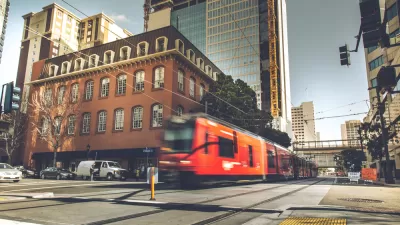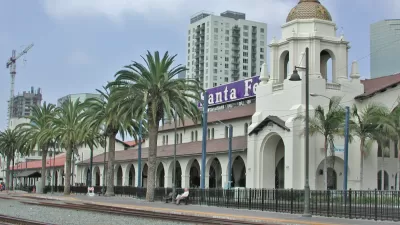Despite slowing population growth statewide, officials believe the region will "grow into" the new rail system if cities promote dense development around transit stations.

[Updated June 1, 2021] The success of an ambitious $160-billion plan for public transit and high-speed rail in San Diego depends on the region's future development, writes Joshua Emerson Smith in the San Diego Union-Tribune. With San Diego's—and California's—population growth rate slowing to a near halt, cities must "usher in dense urban development around transit stations" to make the new rail system effective. "Population growth is a bit less important than where that growth occurs," says Ethan Elkind, director of the climate program at UC Berkeley’s Center for Law, Energy and the Environment.
Critics of the plan say that "San Diego doesn’t have much of a chance of building the type of urban communities that would justify tens of billions of dollars in transit projects." Local communities, which "have bitterly fought housing requirements in court," have for decades challenged new multi-family housing construction in and around San Diego. Unlike other urban rail systems, San Diego's "would service a region with dispersed employment hubs, often featuring office parks with plentiful parking." Community activists also have concerns about displacement, access, and making urgent improvements to existing transit systems. "Advocates for low-income communities say they will support SANDAG’s new transportation plan, but only if the final version prioritizes immediate upgrades to the region’s bus and trolley systems."
"The phasing of various projects is still being determined, as is the financing. A tax initiative that spells out both could be put to voters as early as 2022."
FULL STORY: San Diego’s high-speed rail plan hinges on urban density as population growth wanes

Planetizen Federal Action Tracker
A weekly monitor of how Trump’s orders and actions are impacting planners and planning in America.

Congressman Proposes Bill to Rename DC Metro “Trump Train”
The Make Autorail Great Again Act would withhold federal funding to the system until the Washington Metropolitan Area Transit Authority (WMATA), rebrands as the Washington Metropolitan Authority for Greater Access (WMAGA).

DARTSpace Platform Streamlines Dallas TOD Application Process
The Dallas transit agency hopes a shorter permitting timeline will boost transit-oriented development around rail stations.

Supreme Court Ruling in Pipeline Case Guts Federal Environmental Law
The decision limits the scope of a federal law that mandates extensive environmental impact reviews of energy, infrastructure, and transportation projects.

Texas State Bills to Defund Dallas Transit Die
DART would have seen a 30% service cut, $230M annual losses had the bills survived.

Bikeshare for the Win: Team Pedals to London Cricket Match, Beats Rivals Stuck in Traffic
While their opponents sat in gridlock, England's national cricket team hopped Lime bikes, riding to a 3-0 victory.
Urban Design for Planners 1: Software Tools
This six-course series explores essential urban design concepts using open source software and equips planners with the tools they need to participate fully in the urban design process.
Planning for Universal Design
Learn the tools for implementing Universal Design in planning regulations.
Roanoke Valley-Alleghany Regional Commission
City of Mt Shasta
City of Camden Redevelopment Agency
City of Astoria
Transportation Research & Education Center (TREC) at Portland State University
US High Speed Rail Association
City of Camden Redevelopment Agency
Municipality of Princeton (NJ)




























